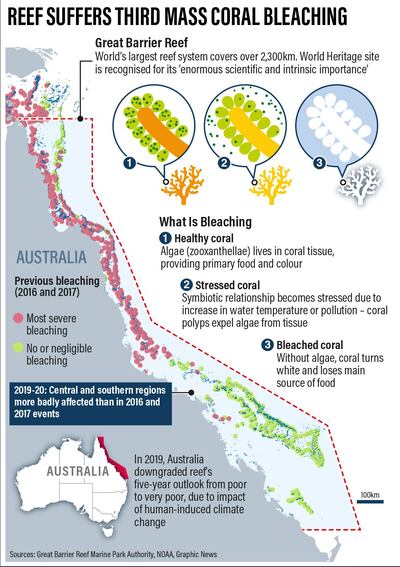Major coral loss in the world’s largest reef system is feared after the third mass bleaching event in just five years.
Heat stress from higher sea temperatures over the 2019/2020 summer, particularly in February this year, has caused extensive patches of severe damage to the Great Barrier Reef in Australia.
Aerial surveys being completed this week will provide a fuller picture of the extent and severity of the episode, but findings so far indicate that the impact is “very widespread,” the Great Barrier Reef Marine Park Authority said.
The natural wonder, which is made up of over 2,900 individual reefs spanning an area of about 344,000 square metres, has experienced four previous bleaching events, one in 1998, another in 2002, and two consecutive episodes in 2016 and 2017.
Some southern areas of the reef that escaped these recent events have now experienced moderate or severe bleaching in the latest temperature rise.
Key tourism reefs in the Northern and Central areas, including near Cairns and Port Douglas, experienced only moderate bleaching, from which most corals should recover, the authority said. Other pockets were unaffected.
Bleaching occurs when abnormal conditions, such as warmer or colder waters, or higher levels of acidity, stress the corals into expelling tiny photosynthetic algae that live in their tissue and create their extraordinary colours.
The algae provides up to 90 per cent of the coral’s energy and without it, they weaken and die, turning ghostly white in the process.
Not all bleached corals will be lost – mildly or moderately affected reefs may recover and survive the event. But on those reefs affected by severe bleaching, the mortality rate will be higher.
“Climate change remains the single greatest challenge to the reef,” the authority said in a statement. “While the strongest possible global efforts to reduce emissions are essential, it is critically important we continue to deliver the work already being undertaken to enhance the resilience of the reef.”
In-water and aerial surveys, citizen science, and forecast and heat mapping tools from the Bureau of Meteorology and US National Oceanic and Atmospheric Administration were used to monitor the reef over the summer.
Further analysis from aerial surveys being completed on Friday will enable the authority to compare the latest bleaching to events in 2016 and 2017.
"The reef had only just begun recovering from impacts in 2016 and 2017 and now we have a third event," chief scientist David Wachenfeld told the BBC.
"The reef is still a vibrant, dynamic system but overall, with every one of these successive events, the reef is more damaged than previously," he said.
The Australian Government is investing $1.9 billion to support the $2.7 billion Reef 2050 Plan, which will see more rangers on the water to increase compliance and reef management activities.


